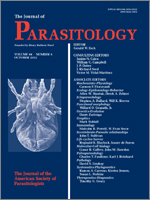During a study of the endohelminths of aquatic birds from the central flyway of North America, the details of the paranephridial systems of 3 immature specimens of Prohyptiasmus sp. were examined; the worms had been collected by the late Dr. J. Teague Self, former Professor, Department of Zoology, University of Oklahoma, Norman, Oklahoma from an American coot, Fulica americana (Raillidae), from the Cheyenne Bottoms, Roger Mills County, Oklahoma and deposited in the Harold W. Manter Laboratory of Parasitology. The excretory vesicle was Y-shaped and had a reduced stem. There were 3 main excretory canals on each side that, in the case of the most lateral 2 pairs, reached anteriorly to the level of the oral sucker. The most lateral canals entered the excretory vesicle about halfway down the stem on each side; the middle canals entered the vesicle at the tips of the branches of the vesicle; and the most medial canals entered the vesicle on the anterior edge about halfway between the branch point and the tips of the branches. There were numerous smaller secondary canals that interconnected with each other and with the 6 main paranephridial canals, forming a net-like system.
How to translate text using browser tools
1 October 2012
Details of the Paranephridial System of a Species of Prohyptiasmus (Cyclocoelidae: Hyptiasminae) From an American Coot, Fulica americana (Rallidae) in Oklahoma
Norman O. Dronen,
F. Agustín Jiménez,
Scott L. Gardner
ACCESS THE FULL ARTICLE

Journal of Parasitology
Vol. 98 • No. 5
October 2012
Vol. 98 • No. 5
October 2012




